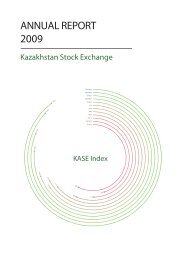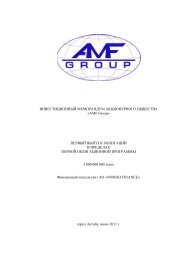Summary Consolidated Financial Data The summary consolidated financial data presented below for the three years ended December 31, 2001 have been derived from our audited consolidated financial statements and the related notes that are included in this offering memorandum. Our annual consolidated financial statements for the periods presented below have been audited by Deloitte & Touche. Our summary consolidated financial data presented below for each of the nine-month periods ended September 30, 2001 and 2002 are derived from our unaudited consolidated financial statements for such periods included elsewhere in this offering memorandum and which, in the opinion of management, include all adjustments (consisting solely of normal recurring adjustments) necessary to present fairly the financial results for such periods. Interim results are not necessarily indicative of the results which may be expected for any other interim period or for the full year. You should read the summary consolidated financial data in conjunction with the information contained in “Risk Factors”, “Capitalization”, “Selected Historical Financial Data”, “Management’s Discussion and Analysis of Financial Condition and Results of Operations”, “Business and Properties”, our consolidated financial statements, including the related notes, and the other financial data appearing elsewhere in this offering memorandum. Nine Months Ended September Year Ended December 31, 30, 1999 2000 2001 2001 2002 (unaudited) (in $ thousands, except ratios) Consolidated Statement of Income Data: Canadian GAAP: Revenue: Crudeoil .................................. 153,047 301,216 252,981 193,342 319,606 Refinedproducts ........................... — 203,728 328,958 264,774 240,476 Processing fees ............................. — 11,884 11,008 8,623 2,112 Interestandotherincome ................... 2,196 6,373 10,109 8,094 6,497 Total revenue .............................. 155,243 523,201 603,056 474,833 568,691 Expenses: Production ................................ 34,443 35,302 43,040 29,681 41,669 Royalties .................................. 16,652 33,709 35,504 30,748 43,709 Transportation ............................. 17,016 25,152 50,237 34,218 100,131 Refining................................... 2,197 12,583 20,562 14,606 17,607 Crude oil and refined product purchases ....... — 48,100 78,788 60,862 50,414 Selling .................................... — 7,728 19,277 15,057 18,724 General and administrative .................. 35,039 44,565 55,204 35,355 42,270 Interestandfinancingcosts .................. 23,874 18,708 19,530 12,126 26,078 Depletion and depreciation .................. 4,991 14,680 34,254 24,618 29,064 Foreign exchange loss (gain) ................. 7,647 (2,266) 1,453 435 1,771 Total expenses ............................. 141,859 238,261 357,849 257,706 371,437 Income before unusual items ................. 13,384 284,940 245,207 217,127 197,254 Unusual items: Defense costs related to potential takeover .... — — 5,546 6,000 — Gain recognized on sale of assets ............. (12,800) — — — — Arbitration settlement ...................... — — — — 7,134 Waiver fees and debt restructuring costs ....... — 20,373 — — — Income before income taxes ................. 26,184 264,567 239,661 211,127 190,120 Income taxes: Current provision ........................... 17,671 100,708 79,679 67,377 64,706 Futureincometax .......................... — (1,051) (11,285) (3,699) 6,312 Total income taxes .......................... 17,671 99,657 68,394 63,678 71,018 Net income before minority interest .......... 8,513 164,910 171,267 147,449 119,102 Minority interest ........................... — 9,980 1,927 1,153 1,672 Netincome ................................ 8,513 154,930 169,340 146,296 117,430 U.S. GAAP: Netincome ............................... 6,502 165,971 162,643 146,296 117,401 10
Nine Months Ended Year Ended December 31, September 30, 1999 2000 2001 2001 2002 (unaudited) (in $ thousands, except ratios) Consolidated Balance Sheet Data (at end of period): Canadian GAAP: Cash and short-term deposits ................ 30,748 59,298 64,812 99,248 162,246 Working capital/(deficit) (1) ................... (176,396) 33,808 61,393 89,741 168,762 Totalassets ............................... 141,437 414,526 572,470 527,153 737,384 Total long-term debt (2) ..................... — 82,048 277,767 249,125 293,197 Total shareholders’ equity/(deficit) ........... (87,582) 185,043 132,140 108,799 247,223 U.S. GAAP: Total shareholders’ equity ................... (117,693) 140,800 79,603 63,387 186,593 Other Financial Data: EBITDA (3) ................................. 55,049 287,975 291,518 246,718 243,590 Capital expenditures ....................... 15,318 21,627 110,207 55,215 101,559 Ratio of EBITDA to cash interest expense ...... 2.3x 15.4x 14.9x 20.3x 9.3x Ratio of earnings to fixed charges (4) .......... 2.1x 15.1x 13.2x 18.4x 8.3x Ratio of net debt to EBITDA (5)(6) .............. 3.0x 0.2x 0.9x 0.6x 0.6x (1) Working capital comprises current assets less current liabilities. (2) $61.1 million and $62.7 million of these amounts represent non-recourse debt incurred by our Kazgermunai joint venture as of December 31, 2001 and September 30, 2002, respectively. (3) “EBITDA” is defined as earnings before interest, dividends paid on preference securities, income taxes, depreciation, depletion and amortization. EBITDA is presented as additional information because we understand that it is one measure used by certain investors to determine our operating cash flow and historical ability to meet debt service and capital expenditure requirements. However, other companies may present EBITDA differently than we do. EBITDA is not a measure of financial performance under generally accepted accounting principles and should not be considered as an alternative to cash flow from operating activities or as a measure of liquidity or an alternative to net income as indicators of our operating performance or any other measures of performance derived in accordance with generally accepted accounting principles. (4) The term “earnings” is the amount of income before income taxes from continuing operations before adjustment for minority interests in consolidated subsidiaries or income or loss from equity investees, plus fixed charges, plus amortization of capitalized interest, plus distributed income to equity investees, plus the share of pre-tax losses of equity investees for which charges arising from guarantees are included in fixed charges, less interest capitalized, less preference security dividend requirements of consolidated subsidiaries, less the minority interest in pre-tax income of subsidiaries that have not incurred fixed charges and less unusual items. The term “fixed charges” means the sum of the following: (a) interest expensed or capitalized, (b) amortized premiums, discounts and capitalized expenses related to indebtedness, (c) an estimate of the interest within rental expense, and (d) preference security dividend requirements of consolidated subsidiaries. The term “preference security dividend” is the amount of pre-tax earnings that is required to pay the dividends on outstanding preference securities, computed as the amount of the dividend divided by one minus the effective income tax rate applicable to continuing operations. (5) “Net debt” represents total debt less cash and cash equivalents. (6) Nine month figures are calculated on an annualized basis. 11
- Page 1 and 2: Offering Circular Hurricane Finance
- Page 3 and 4: Moscow RUSSIA SAMARA Ufa OMSK RUSSI
- Page 5 and 6: Š Š you have made certain acknowl
- Page 7 and 8: Unless otherwise indicated, all ref
- Page 9 and 10: Notice to New Hampshire Residents N
- Page 11 and 12: Offering Memorandum Summary This su
- Page 13 and 14: have a network of sales, storage an
- Page 15 and 16: Š our QAM pipeline construction pr
- Page 17 and 18: a senior intercompany loan to HKM.
- Page 19: Organizational Structure The follow
- Page 23 and 24: Year Ended December 31, 2001 Nine M
- Page 25 and 26: construction of the plant, anticipa
- Page 27 and 28: Inadequate infrastructure could adv
- Page 29 and 30: fully prohibit us from doing so. In
- Page 31 and 32: Kazakhstan’s foreign investment,
- Page 33 and 34: subsoil user and the Kazakhstani go
- Page 35 and 36: In general, estimates of economical
- Page 37 and 38: thereon and any other amounts owed
- Page 39 and 40: Selected Historical Consolidated Fi
- Page 41 and 42: Management’s Discussion and Analy
- Page 43 and 44: (11,642 tonnes per day) in Septembe
- Page 45 and 46: Adoption of Certain Accounting Stan
- Page 47 and 48: The following table sets out the so
- Page 49 and 50: The total royalty and tax expense f
- Page 51 and 52: perform a quarterly ceiling test. T
- Page 53 and 54: The increase in FCA differentials p
- Page 55 and 56: In addition, we incurred production
- Page 57 and 58: plan. The CCAA plan was implemented
- Page 59 and 60: Royalties Royalties increased from
- Page 61 and 62: Cash is managed centrally through t
- Page 63 and 64: Š completion of the gas utilizatio
- Page 65 and 66: Competitive Strengths We believe th
- Page 67 and 68: Š refurbishing and recommissioning
- Page 69 and 70: The daily business of Kazgermunai i
- Page 71 and 72:
Kumkol North. We have a 50% interes
- Page 73 and 74:
are currently five producing wells.
- Page 75 and 76:
Estimated Reserves and Present Wort
- Page 77 and 78:
The following table sets forth a re
- Page 79 and 80:
The following tables show our avera
- Page 81 and 82:
amended in April 1999, required Kaz
- Page 83 and 84:
price we paid for the shares of HKM
- Page 85 and 86:
expenditures or investments. The ag
- Page 87 and 88:
Several investments with high profi
- Page 89 and 90:
In addition, we have opened new rou
- Page 91 and 92:
On January 8, 2003, the President o
- Page 93 and 94:
As a result of these discussions, H
- Page 95 and 96:
Management Directors and Senior Man
- Page 97 and 98:
and managerial positions. In 1992,
- Page 99 and 100:
approved by our shareholders in Nov
- Page 101 and 102:
Related Party Transactions Set fort
- Page 103 and 104:
Indebtedness of Directors and Senio
- Page 105 and 106:
Prepayments HKM may voluntarily pre
- Page 107 and 108:
guarantees any Indebtedness of an O
- Page 109 and 110:
will also (i) make such withholding
- Page 111 and 112:
The Change of Control Offer will re
- Page 113 and 114:
shown on the most recent balance sh
- Page 115 and 116:
(a) no Default or Event of Default
- Page 117 and 118:
Disqualified Stock and will not per
- Page 119 and 120:
transaction are at least equal to t
- Page 121 and 122:
in HKM or HOP respectively, from th
- Page 123 and 124:
Restricted Subsidiary sell, assign,
- Page 125 and 126:
(2) reduce the rate of interest on
- Page 127 and 128:
Issuer may, at its option and at an
- Page 129 and 130:
(g) waive a redemption payment with
- Page 131 and 132:
issue date of the Notes within the
- Page 133 and 134:
Exchange of Global Notes for Defini
- Page 135 and 136:
Luxembourg or their respective dire
- Page 137 and 138:
the Company or to a Guarantor, (e)
- Page 139 and 140:
“Consolidated Net Income” means
- Page 141 and 142:
excluded, and (iii) the Fixed Charg
- Page 143 and 144:
shall be deemed to make an “Inves
- Page 145 and 146:
or is liquidated into, the Company
- Page 147 and 148:
Value, as appropriate, of such prop
- Page 149 and 150:
“Wholly Owned Restricted Subsidia
- Page 151 and 152:
Sale, Redemption or Retirement of t
- Page 153 and 154:
Tax on Income and Capital Gains A h
- Page 155 and 156:
Plan of Distribution Subject to the
- Page 157 and 158:
Pre-Issue Trades Settlement It is e
- Page 159 and 160:
Regulation S Notes By purchasing no
- Page 161 and 162:
The issuer’s principal activities
- Page 163 and 164:
Lengesskoe Shosse, Shymkent, Yuzhna
- Page 165 and 166:
4 The issue of the notes was author
- Page 167 and 168:
Hurricane Hydrocarbons Ltd. Interim
- Page 169 and 170:
Hurricane Hydrocarbons Ltd. Interim
- Page 171 and 172:
3 months ended September 30, 2002 U
- Page 173 and 174:
3 months ended September 30, 2001 U
- Page 175 and 176:
9 months ended September 30, 2001 T
- Page 177 and 178:
Repayment Long term debt principal
- Page 179 and 180:
14 Net Income Per Share The income
- Page 181 and 182:
accordingly no compensation cost ha
- Page 183 and 184:
Management’s Report All informati
- Page 185 and 186:
Comments by auditor for U.S. reader
- Page 187 and 188:
Hurricane Hydrocarbons Ltd. Consoli
- Page 189 and 190:
Hurricane Hydrocarbons Ltd. Notes t
- Page 191 and 192:
accordance with current legislation
- Page 193 and 194:
In addition the Corporation has now
- Page 195 and 196:
Upstream Downstream Eliminations Co
- Page 197 and 198:
The crude oil sales elimination of
- Page 199 and 200:
The Canadian Notes contained certai
- Page 201 and 202:
Interest expense Interest expense f
- Page 203 and 204:
14 Income Taxes The Corporation and
- Page 205 and 206:
investments or other items that may
- Page 207 and 208:
19 Related Party Transactions Durin
- Page 209 and 210:
Consolidated Balance Sheets The app
- Page 211 and 212:
Legal Proceedings The Corporation h
- Page 213 and 214:
Non-FCA sales ................ Oil
- Page 215 and 216:
APPENDIX B: The Republic of Kazakhs
- Page 217 and 218:
Under the Constitution, the Preside
- Page 219 and 220:
International Organizations and Int
- Page 221 and 222:
The Kazakhstan Economy Overview Kaz
- Page 223 and 224:
Principal Sectors of the Economy Hi
- Page 225 and 226:
Oil and Gas For Oil and Gas see Ann
- Page 227 and 228:
Public Finance Introduction Fiscal
- Page 229 and 230:
The exchange rate regime adopted in
- Page 231 and 232:
The following table sets forth data
- Page 233 and 234:
(This page has been left blank inte
- Page 235 and 236:
Exports General In 2001, the export
- Page 237 and 238:
‰ preparing and implementing new
- Page 239:
THE ISSUER Hurricane Finance B.V. S
















